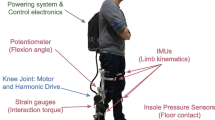Abstract
In this study, an ideal electromechanical KAFO, satisfying stability in the stance and knee flexion in the swing phase during walking, was developed. Biomechanical evaluations were performed on four polio patients by means of three-dimensional gait analyses and energy consumption studies. From the three-dimensional gait analysis on poliomyelitis patients, a considerable amount of knee flexion during the swing phase was observed in controlled-knee gait, which resulted in approximately 33% less energy consumption than in locked-knee gait. The developed electromechanical KAFO in this study was helpful in poliomyelitis patients having partial or complete paralysis of the lower extremity, providing both stability in the stance and free swinging of the knee. This unit was efficient in the transfer of energy.





Similar content being viewed by others
References
Cerny K, Waters RL, Hislop H, Perry J (1980) Walking and wheelchair energetics in persons with paraplegia. Phys Ther 60:1133–1139
Coghlin JK, Robinson CE, Newmarch B, Jackson G (1980) Lower-extremity bracing in paraplegia: a follow-up study. J Paraplegia 18:25–32
Davis RB, Ounpuu S, Tyburski D, Gage JR (1991) A gait analysis data collection and reduction technique. Human Mov Sci 10:575–587
Hebert JS, Liggins AB (2005) Gait evaluation of an automatic stance-control knee orthosis in a patient with postpoliomyelitis. Arch Phys Med Rehabil 86:1676–1680
Hislop HJ, Montgomery J (2002) Daniels & Worthingham’s muscle testing: techniques of manual examination. Saunders, Philadelphia, pp 2–3
Horn GW (1972) Electro-Control: An EMG-Controlled A/K Prosthesis. Med Biol Eng Comput 10:61–73
Hussey RW, Stauffer ES (1973) Spinal cord injury: requirements for ambulation. Arch Phys Med Rehabil 54:544–547
Inman V (1969) Conservation of energy and ambulation. Bull Prosthet Res 10:26
Irby SE (1994) A digital logic controlled electromechanical free knee brace. MS Thesis. San Diego State University, San Diego, CA, USA
Irby SE, Bernhardt KA, Kaufman KR (2005) Gait of stance control orthosis users: the dynamic knee brace system. Prosthet Orthot Int 29(3):269–282
Jessica RP, James GG (1994) Human walking: Second edn. Williams & Wilkins, Baltimore, pp 47–72
Krewer C, Muller F, Husemann B, Heller S, Quintern J, Koenig E (2007) The influence of different Lokomat walking conditions on the energy expenditure of hemiparetic patients and healthy subjects. Gait Posture 26(3):372–377
Leerdam NGA, Cool JC (1992) Load Measurement on the UTX-Orthosis. J Biomech 25:816–817
Lehmann JF, Stonebridge JB (1978) Knee lock device for knee ankle orthoses for spinal cord injured patients, an evaluation. Arch Phys Med Rehabil 59:430–437
Mattsson E, Bromstrom LA (1990) The increase in energy cost of walking with an immobilized knee or an unstable ankle. Scand J Rehabil Med 22:51–53
Mauch HA. (1967) Research and development in the field of artificial limbs. Bull Prosthet Res 1:143–169
McGhee RB, Tomovic R, Yang PY, Maclean IC (1978) An experimental study of a sensor-controlled external knee locking system. IEEE Trans Biomed Eng BME-25(2):195–199
McMillan G, Kendrick KK, Michael JW, Aronson J, Horton JW (2004) Preliminary evidence for effectiveness of a stance control orthosis. J Prosthet Orthot 16:6–13
Perry J (1967) The mechanics of walking: a clinical interpretation. In: Perry J, Hislop HJ (eds) Principles of the lower-extremity bracing. American Physical Therapy Association, New York, pp 9–32
Philips B, Zhao H (1993) Predictors of assistive technology abandonment. Assist Technol 5:36–45
Rosman M, Spira E (1974) Paraplegic use of locking braces: a survey. Arch Phys Med Rehabil 55:310–314
Ryu T, Choi H, Choi H, Chung M (2006) A comparison of gait characteristics between Korean and Western people for establishing Korean gait reference data. Int J Ind Ergon 36:1023–1030
Sawicki GS, Ferris DP (2006) Mechanics and control of a knee ankle foot orthosis (KAFO) powered with artificial pneumatic muscles. J Biomechanicas 39:S109
Tomovic R, McGhee RB (1966) A finite state approach to the synthesis of bioengineering control systems. IEEE Trans Human Factors Electron HFE-7(2):65–69
Waters RL, Campbell J, Thomas L, Hugos L, Davis P (1982) Energy cost of walking in lower-extremity plaster casts. J Bone Joint Surg 64:896–899
Winter DA (1991) The biomechanics and motor control of human gait: normal, elderly and pathological. University of Waterloo Press, Waterloo, pp 43–127
Yang PY (1975) A study of electronically controlled orthotic knee joint systems. Ph.D. Dissertation. Ohio State University, Columbus, OH, USA
Yakimovich T, Lemaire ED, Kofman J (2006) Preliminary kinematic evaluation of a new stance-control knee-ankle-foot orthosis. Clin Biomechancis 21:1081–1089
Acknowledgements
This study was supported by a grant of the Korea Health 21 R&D Project, Ministry of Health & Welfare, Republic of Korea (02-PJ3-PG6-EV03-0004) and was also supported by the Regional Innovation Center Program, conducted by the Ministry of Commerce, Industry and Energy of the Korean Government.
Author information
Authors and Affiliations
Corresponding author
Rights and permissions
About this article
Cite this article
Hwang, S., Kang, S., Cho, K. et al. Biomechanical effect of electromechanical knee–ankle–foot-orthosis on knee joint control in patients with poliomyelitis. Med Biol Eng Comput 46, 541–549 (2008). https://doi.org/10.1007/s11517-008-0310-6
Received:
Accepted:
Published:
Issue Date:
DOI: https://doi.org/10.1007/s11517-008-0310-6




